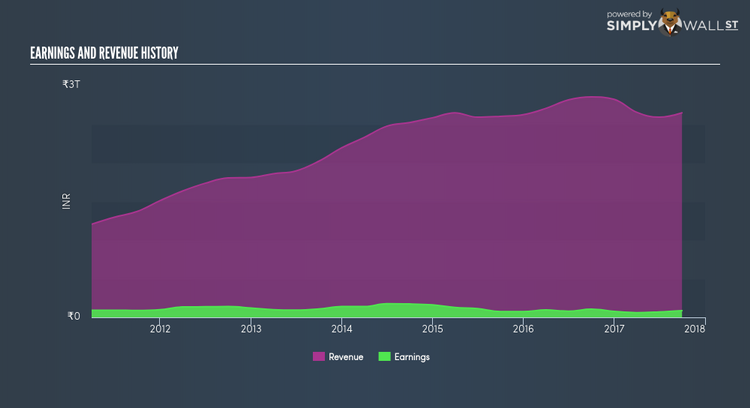Does Tata Motors Limited’s (NSE:TATAMOTORS) Past Performance Indicate A Weaker Future?

Examining Tata Motors Limited’s (NSEI:TATAMOTORS) past track record of performance is a useful exercise for investors. It allows us to reflect on whether the company has met or exceed expectations, which is a powerful signal for future performance. Below, I will assess TATAMOTORS’s latest performance announced on 30 September 2017 and weight these figures against its longer term trend and industry movements. View our latest analysis for Tata Motors
How Did TATAMOTORS’s Recent Performance Stack Up Against Its Past?
I look at the ‘latest twelve-month’ data, which annualizes the latest 6-month earnings release, or some times, the latest annual report is already the most recent financial data. This technique allows me to examine different companies on a similar basis, using the most relevant data points. “For Tata Motors, its “, latest earnings is ₹87,213.5M, which, against the previous year’s level, has plunged by -17.87%. Given that these figures are relatively short-term, I’ve determined an annualized five-year value for TATAMOTORS’s earnings, which stands at ₹110,194.8M. This doesn’t seem to paint a better picture, as earnings seem to have gradually been declining over time.

Why is this? Well, let’s take a look at what’s occurring with margins and whether the rest of the industry is experiencing the hit as well. Revenue growth over the past few years, has been positive, nevertheless earnings growth has been falling. This means Tata Motors has been increasing expenses, which is hurting margins and earnings, and is not a sustainable practice. Looking at growth from a sector-level, the IN auto industry has been relatively flat in terms of earnings growth over the previous few years. This means that whatever near-term headwind the industry is experiencing, it’s hitting Tata Motors harder than its peers.
What does this mean?
Tata Motors’s track record can be a valuable insight into its earnings performance, but it certainly doesn’t tell the whole story. Generally companies that experience a drawn out period of diminishing earnings are undergoing some sort of reinvestment phase . Though if the whole industry is struggling to grow over time, it may be a sign of a structural change, which makes Tata Motors and its peers a higher risk investment. You should continue to research Tata Motors to get a better picture of the stock by looking at:
1. Future Outlook: What are well-informed industry analysts predicting for TATAMOTORS’s future growth? Take a look at our free research report of analyst consensus for TATAMOTORS’s outlook.
2. Financial Health: Is TATAMOTORS’s operations financially sustainable? Balance sheets can be hard to analyze, which is why we’ve done it for you. Check out our financial health checks here.
3. Other High-Performing Stocks: Are there other stocks that provide better prospects with proven track records? Explore our free list of these great stocks here.
NB: Figures in this article are calculated using data from the last twelve months, which refer to the 12-month period ending on the last date of the month the financial statement is dated. This may not be consistent with full year annual report figures.
To help readers see pass the short term volatility of the financial market, we aim to bring you a long-term focused research analysis purely driven by fundamental data. Note that our analysis does not factor in the latest price sensitive company announcements.
The author is an independent contributor and at the time of publication had no position in the stocks mentioned.
